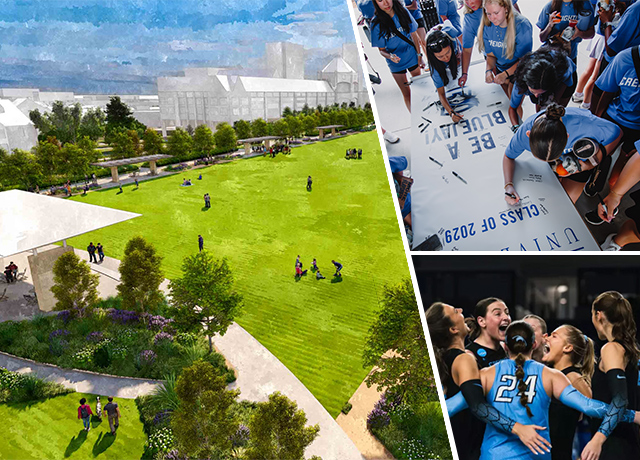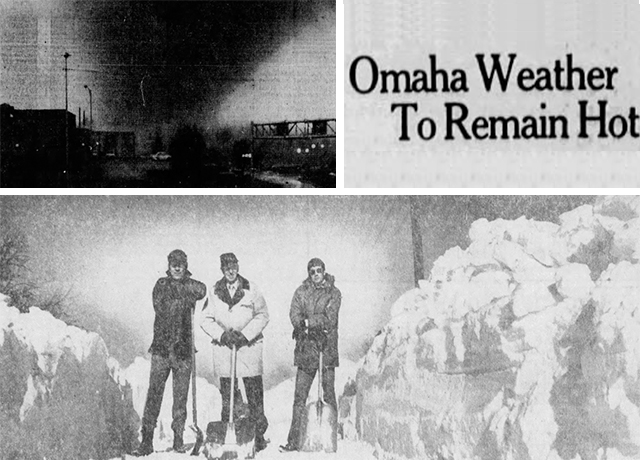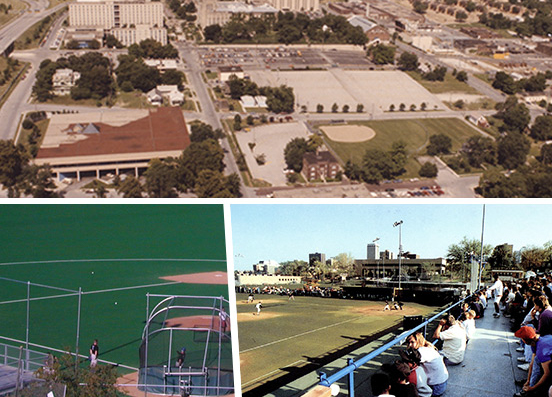Featured Testimonial About Creighton University

Listen to a new episode of Weird Creighton History, in which we discuss the batch of 2023 Creighton anniversaries featured in this article.
* * *
By Micah Mertes
This is the second part of our three-part series on Creighton anniversaries in 2023. Find the previous and subsequent entries at the links below.
Part One: 1893-1943 — The first master’s degree, a new mascot, the Bluejay who won WWII
Part Three: 1983-2022 — The ‘Eternal Flame,’ a national championship, an alum goes to space
75 years
1948 — The DePorres Club gets to work
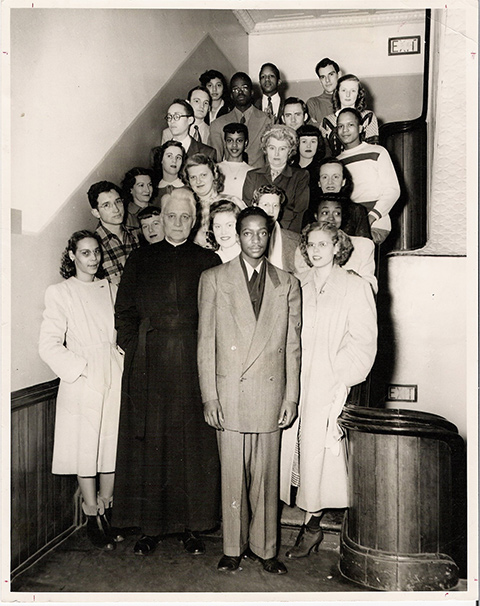
The club — one of America’s earliest civil rights organizations — had been founded the previous year on Creighton’s campus by a group of interracial students and local activists under the leadership of Creighton math and philosophy professor the Rev. John P. Markoe, SJ. Its goals were to establish “better racial relations through constructive actions, to banish every form of compulsory segregation and abolish any and all forms of discrimination against individuals because of race, color or creed.”
The DePorres Club started as both a prayer group and a way for students and members of the community to discuss racial justice. But in 1948, it became something more, after 30 members staged a sit-in at a Douglas County Courthouse diner that refused to serve Black customers.
That year, the club continued to take its fight for racial equality into the community, launching campaigns to end racism in Omaha industries and push Catholic churches to allow Black students in their schools. The club filed lawsuits and led boycotts against Omaha restaurants, swimming pools, barber shops, hotels, any and every place that refused to serve or hire Black people.
The DePorres Club soon became so controversial that Creighton administration told the group to stop meeting on campus. They found a new home at 24th and Grace in North Omaha, forming the Omaha DePorres Center. They later moved into the Omaha Star offices free of charge, thanks to the support of publisher Mildred Brown.
The University would eventually come to honor the pioneering work of the DePorres Club and Fr. Markoe, founding the Markoe-DePorres Social Justice Lecture Series. The club’s spirit continues today through the Creighton community’s continual efforts to promote equity, diversity and inclusion, on campus and beyond.
If you want to read more about the club and the fascinating Fr. Markoe (who, incidentally, was lifelong friends with President Dwight D. Eisenhower after the two played football together at West Point), you can read two comprehensive histories here and here.
60 years
1963 — The new Creightonian
This one’s a little obscure, but all you Creighton journalism heads out there will appreciate it … In the fall of 1963, after 15 years of using the same nameplate, the Creightonian showed its new face. The rebooted nameplate was designed by Hilario Perez, an illustrator with Strategic Air Command at Offutt Air Force Base who had been taking night classes at Creighton.
The nameplate — unquestionably one of the coolest in the student newspaper’s 101-year history — was a handwritten script with a Creighton Bluejay perched on the lower lip of the “C.” As then-assistant professor of journalism Charles A. Zuegner said of the nameplate at the time, “It’s got guts.” Here here.

1963 — Criss I is completed
Criss I opened in the fall of ’63 as a building solely devoted to research facilities. Much was made of just how much space it brought to Creighton’s research efforts. The Omaha World-Herald even noted it in a headline: “C.U. Medical Researchers Enjoying Luxury of Space.”
Criss I would of course lead to Criss II and Criss III, which were recently connected via skybridge to the CL and Rachel Werner Center for Health Sciences Education, slated to open this fall.
1963 — A declaration of antiracism
Sixty years ago, Creighton took a major step toward greater racial justice on campus, when the board of directors approved a declaration reaffirming the University’s commitment to complete integration and stating that Creighton is “vigorously opposed to all forms of racism.”
The declaration also ensured that, in accordance with residence hall and dining room policy already in place, all off-campus housing must be fully integrated if students wished to live there.
50 years

1973 — The first intercollegiate women’s sport
One year after Title IX was signed into law, softball became the first organized, intercollegiate women’s sport at Creighton.
Eventual softball coach and Creighton hall-of-famer Mary Higgins, BA’73, was one of the “founding mothers” of the program. When she was a senior, she and a group of other students went to then-assistant Athletic Director Dan Offenburger to pitch him a softball team. He told them he and others would study the idea.
“We said we want to have the sport, and we want to have it this spring,” Higgins told the Omaha World-Herald last year. “We don’t want it to go to a committee. We want to have it this year because so many of us are seniors.”
That convinced Offenburger. He agreed to coach the newly formed team, while the players would purchase their uniforms and schedule their games themselves.
The era of women’s athletics at Creighton had begun. (Fifty years later, a new era begins for Creighton softball, with the arrival of a new head coach — and just the third official head coach in the team’s history — Krista Wood.)
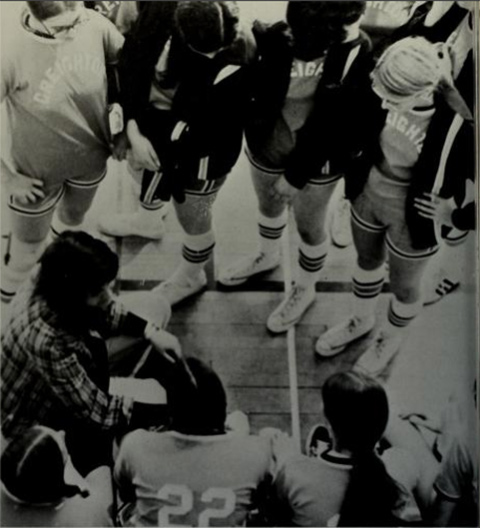
1973 — The start of women’s basketball, volleyball and swimming
The fall after softball got female student-athletes in the game, Creighton Athletics launched three additional women’s sports, hiring Eddye McClure to coach the basketball team and Meta Johnson to coach swimming and volleyball.
Though the women’s basketball program continued for the next 50 years, the volleyball team was dropped in 1981 and the swimming program (both men’s and women’s) in 1990. The program cuts were due to everything from shifting NCAA regulations to recruitment woes to a lack of finances to (in the case of swimming) the Kiewit Fitness Center pool not reaching regulation length or depth.
Creighton’s intercollegiate volleyball team returned in 1994, gradually growing into the powerhouse program that, last fall, claimed its eighth BIG EAST Tournament title in the past nine years.
1973 — The School of Law’s first female faculty member

That fall semester, Frances Ryan joined the faculty to teach courses on income tax, trusts and wills. Ryan was a trailblazer in many ways, but she’s best remembered as a champion of diversity, for her work recruiting, mentoring and advocating for law students from underrepresented groups.
Her dedication to students lives on through a scholarship in her name.
1973 — Creighton breaks ground on Ahmanson Law Center
The Leo A. Daly Company-designed building remains the law school’s home today.
1973 — A new dental school building
The state-of-the art Boyne School of Dental Science accommodated the School of Dentistry’s ever-cresting enrollment with fully equipped labs and a main clinic with more than 100 teaching stations.
1973 — Air conditioning comes to the residence halls

Well, actually it was initially only installed in one residence hall: Swanson. To be fair, Swanson was and still is the biggest hall. But to any former residents of Gallagher, Kiewit or Deglman who graduated before ’73, please accept this belated apology for your sweaty discomfort.
1973 — Farewell, Walt
The original proprietor of Beal’s Grill — the iconic Creighton restaurant at the southeast corner of 24th and California Streets from 1940 to 1986 — had a rather colorful vocabulary, hurling creative, affectionate insults to his many regular customers. (Subsequent Beal’s owner Howard Fiedler continued this tradition after his father-in-law passed down his stained apron and spatula.) But Walt’s gruff and crusty exterior couldn’t quite hide his heart of gold.
The Rev. Neil Cahill, SJ, BS’43, MS’77, delivered Walt Beal’s funeral mass (held at St. John’s Church, of course). Fr. Cahill, who had worked behind the counter of Beal’s while he was an undergraduate, recalled a man who could always be counted on.
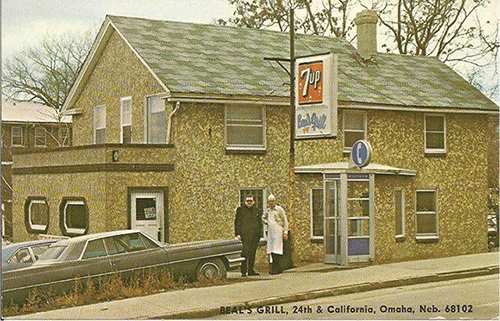
Walt always offered free meals to students short on cash (“Hey, you gotta eat,” he’d tell them. “Pay me when you can.”). He was also known to loan students tuition money, provide free room and board and offer jobs to folks who had fallen on hard times. He loved Creighton athletics and supported teams in a number of (sometimes unconventional) ways, once even bailing a group of Bluejay football players out of jail after they had an altercation with police.
1973 — Creighton gets its own zip code
At the start of the school year, the University was given its own zip code. (It had previously been a part of the 68131 area encompassing campus.) Creighton had a say in the new number and selected 68178, the last two digits reflecting our 1878 founding because, well, anniversaries are kind of a big deal here.
***
This was the second part of our three-part series on Creighton anniversaries in 2023. Find the previous and subsequent entries at the links below.
Part One: 1893-1943 — The first master’s degree, a new mascot, the Bluejay who won WWII
Part Three: 1983-2022 — The ‘Eternal Flame,’ a national championship, an alum goes to space
* * *
Listen to a new episode of Weird Creighton History, in which we discuss the batch of 2023 Creighton anniversaries featured in this article.
